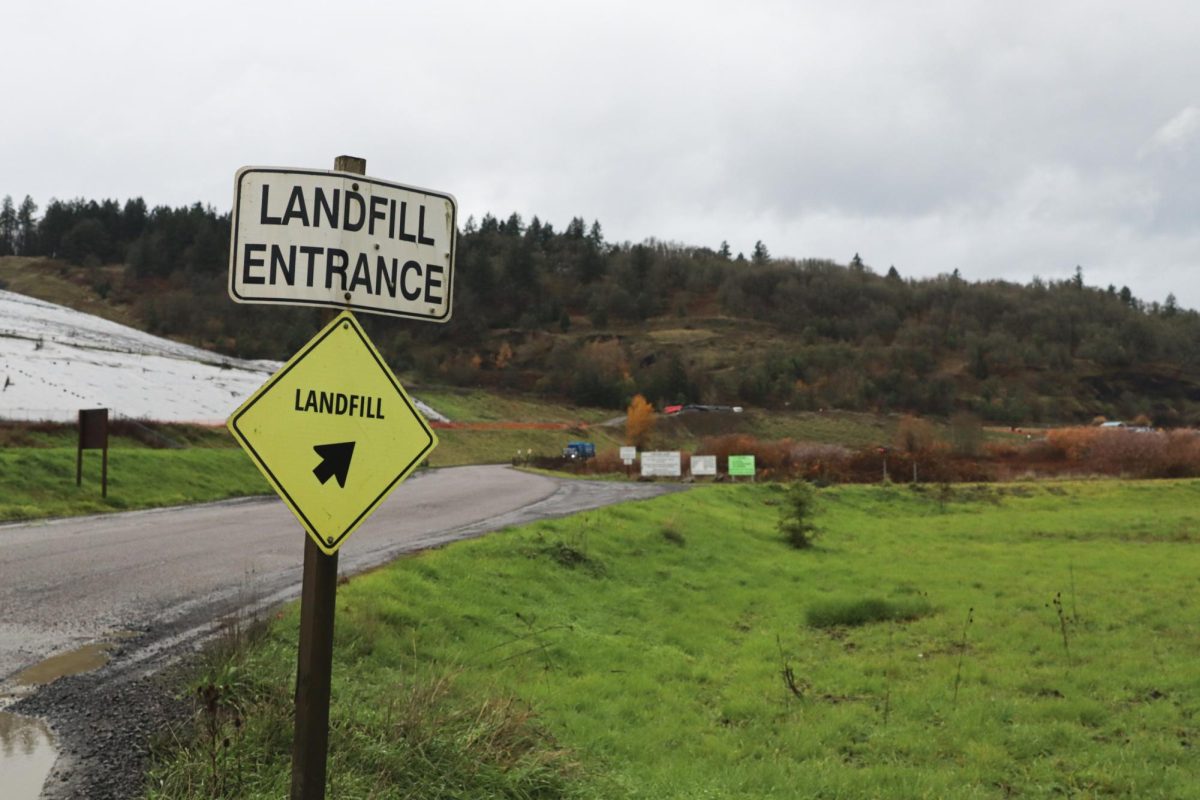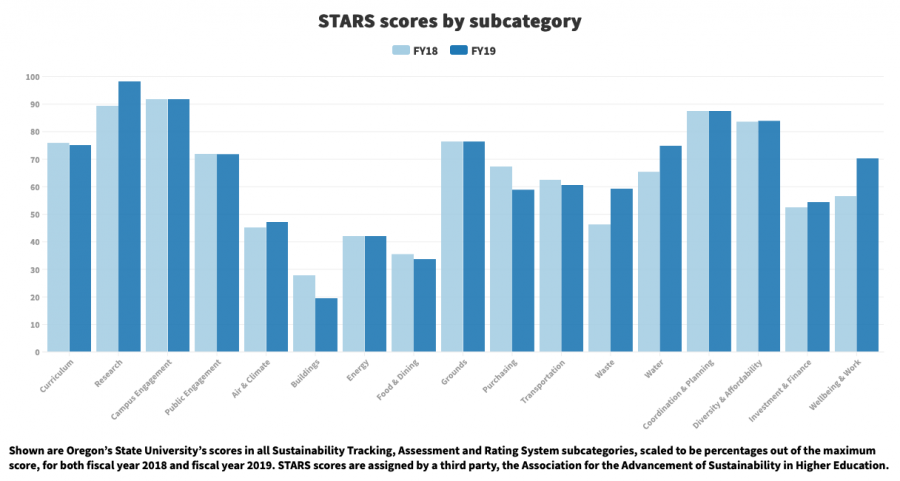OSU Sustainability Report highlights positive trends, room for improvement
March 9, 2020
The Oregon State University Sustainability Office’s recently-released yearly Sustainability Report details how the university achieved a gold rating and the actions that would be required to achieve a platinum score, including making the university’s buildings greener.
The Sustainability Report, written by Sustainability Assessment Manager Lety Cavazos, lists and explains OSU’s Sustainability Tracking, Assessment and Rating System’s scores, which are assigned by the Association for the Advancement of Sustainability in Higher Education, a third-party organization. According to OSU Sustainability Officer Brandon Trelstad, STARS is broken into a four-tier grading system: bronze, silver, gold and platinum. OSU has received the same rating, gold, the last nine years it has undergone a STARS assessment. There are only four platinum schools in the nation.
The Sustainability Report differs from the yearly Greenhouse Gas Inventory Report, which focuses specifically on the university’s greenhouse gas emissions. Cavazos said the Sustainability Report is closely tied to the yearly Greenhouse Gas Inventory Report since the data collected for the Inventory Report is used to determine the university’s STARS rating.
The Sustainability Report breaks down the university’s STARS rating. Cavazos said it provides a more comprehensive view of sustainability at the university than the Greenhouse Gas Inventory Report, since STARS is divided into four categories: academics, engagement, operations and planning, and administration, which are further broken down into individually-scored subcategories.
The report lists and discusses OSU’s high-performing STARS subcategories, including research, campus engagement, coordination and planning, diversity and affordability. Positive trending STARS subcategories—areas in which the university has seen improvement—include research, waste, water, wellbeing and work.
Low-performing STARS subcategories include air and climate, buildings, food and dining, energy, purchasing, investment and finance, and negative trending STARS subcategories include building and purchasing.
“STARS is so nice, because it helps us focus on things that maybe would get forgotten, quite frankly. We’re very focused on carbon emissions reduction, and I think there’s obviously a pretty solid case for that,” Trelstad said. “But, that aside, there are other things that maybe don’t have a direct carbon tie, but if you think about food and materials management, and purchasing, and all these other things, so many of them do roll up to that carbon goal.”
To collect data for each category, the Sustainability Office coordinates with other groups and third parties at the university, including Community Engagement and Leadership, Campus Recycling and University Housing and Dining Services, to name a few. Many of these organizations input their own information directly to STARS each year.
OSU Materials Management Marketing and Development Coordinator Andrea Norris said OSU Materials Management reports information to the STARS “Waste Minimization and Diversion” section, which focuses on how OSU’s waste has improved over time and how much waste OSU is diverting.
“The bottom line is that OSU improved in the category of waste over our previous year because we reduced the total amount of waste we generated (including trash, recycling, compost and reuse) per person while keeping our recycling rate similar and even just a bit higher,” Norris said via email. “Having said that, OSU only scored 4.33 out of the 8 available points in this category and has much room for improvement.”
Norris said while there is a tendency to look for improvements in recycling and composting, it is only a small aspect of improving overall sustainability. Reducing waste and preventing waste production is a focus of OSU Material Management going forward, according to Norris.
Trelstad said the university has a consistently high performance in research, campus engagement, coordination and planning, and diversity and affordability.
“I know that specifically for our STARS score this year compared to last, the biggest contributor to our highest score yet was research,” Cavazos said. “The reason why it bumped up was because there were a lot more departments that had research with a sustainability component.”
According to Cavazos, in order to achieve a higher STARS score or receive a “platinum” grade, the university would have to improve its buildings. Cavazos said improving buildings could also consequently increase credits in other subcategories.
“Investment and finance is really more about the OSU Foundation’s practices, which we don’t really control. We influence, but we don’t control, because they are a separate organization,” Trelstad said. “Everything else (the other low-performing subcategories) is operational—if we were buying more renewable energy, certifying our buildings green from an operational standpoint, or we build green buildings to start with. But then when they’re 50 years old, or really even 5 years old, you need to re-certify them under a different protocol. We really don’t have the capacity to do that, so we haven’t.”
In order to get more building certifications, more staff people would be needed from an operational standpoint, according to Trelstad.
Trelstad said the STARS assessment holds the university accountable, provides an honest and transparent account that highlights low-performing areas and identifies where to focus future sustainability efforts.
“Most of lower scoring credits are not easy things, or else we would be doing them already. If leaders want us to improve, we can do anything given the resources—then, that becomes a leadership decision for them to make,” Trelstad said.
Both Trelstad and Cavazos agreed that the university’s long-term sustainability goal is carbon neutrality.
“We’ve picked a very ambitious goal already around carbon neutrality, and because it touches so many aspects of sustainability, I feel like that’s good enough—it’s too much, quite frankly, to think about how we’re going to get there in 5 years,” Trelstad said. “Or, if we’re not carbon neutral, how can we make really substantial reductions. That’s what we’ve been asked to do now, is to say what would it cost to get us to carbon neutrality, or some level of alternatives where carbon offsets play some role.”
The Fiscal Year 2019 Sustainability Report can be found on OSU’s website.
























































































































